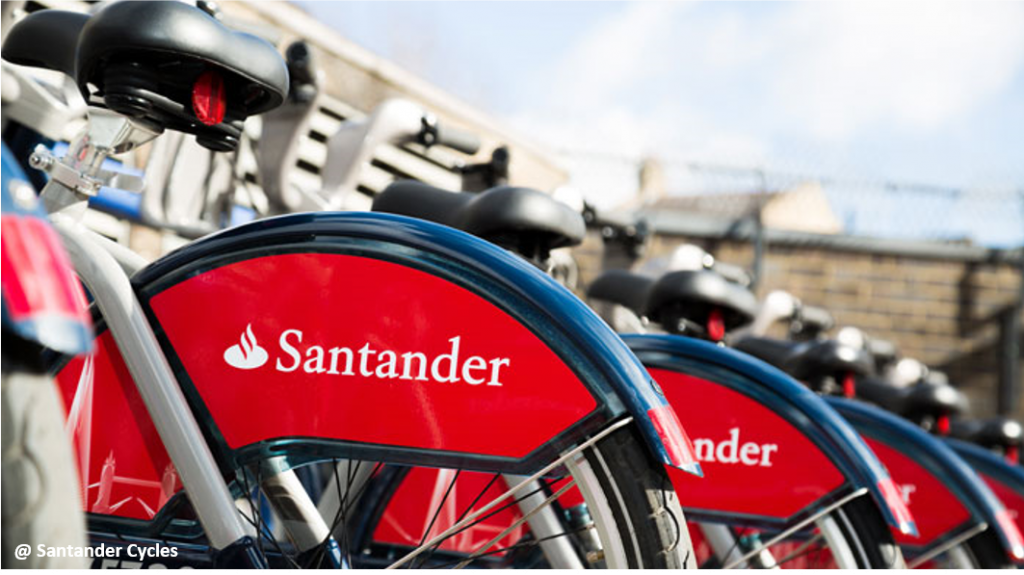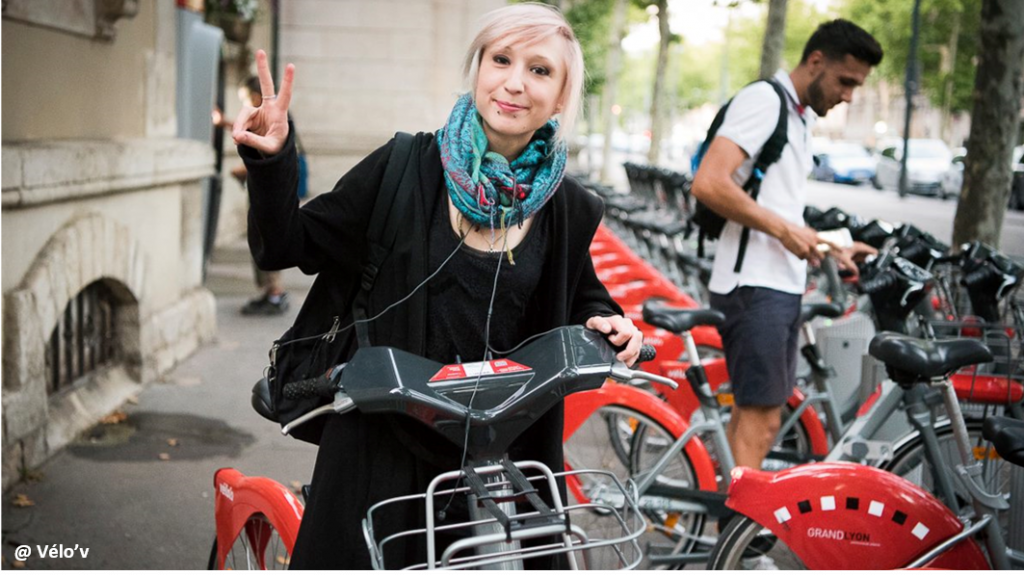
1. Presentation
Bike Sharing Systems consists on the provision of short term renting of bicycles distributed across a network of stations, typically in an urban area, enabling low cost (or no cost) point-to-point trips. They should meet the specific needs of each context (e.g. e-bikes in areas with steep slopes; adapted bicycles for people with reduced mobility).
2. Objectives
- Providing low-cost bicycles systems that allow the connection between different places of urban interest, thus allowing sustainable urban mobility.
- Increasing mobility and accessibility options;
- Promoting multimodal transport;
- Promoting physical activity and the humanization of public space.
3. Measure’s importance
By providing low-cost access to bicycles, this measure allows to increase the levels of bicycle use in the city, thus promoting and normalizing the use of the bicycle as a mode of urban and sustainable transport. At the same time, it allows to complement the use of public transport, being a possible solution to the last mile problem, that is, to reach areas not served by public transport and increase its catchment area.
1. Best Practices
– Bike sharing system should be designed to maximize the convenience of short-distance utility trips, with easy-to-use stations widely distributed throughout the city.
– Particular attention should be given to the availability of bicycles on public transport interfaces.
– It should be integrated with other measures, like the cycling network and education/ information for users.
– If a fee is applied, it should always encourage short-distance utility travel (ideally free or reduced cost for the first 15-20 minutes of use).
– There should be a concern with the design of bicycles and stations to promote their integration into the urban landscape and proper maintenance.
– The system must include a procedure to redistribute bicycles from areas that accumulate them in excess to those in shortage.
– Monitor citizens ‘adaptation to changes and reformulate measures to respond to users’ needs without compromising sustainable ideals (See Management, Monitoring and Maintenance).
– Explain the principles behind the measures to make clear their importance and how they operate (See Information).
2. Actions
 | Manual bicycle sharing system Bicycle loan and return operations are supervised by an employee. Advantages: Less technology needed (easier to maintain and less expensive to implement). Reduces theft and vandalism. Disadvantages: Higher operation costs Lower system reliability. |
 | Automated bicycle sharing system User checks in or out the bikes through the use of automated technologies (self-service). Advantages: Greater integration potential in the urban system. Less operation costs. Sophisticated design. Disadvantages: More complex, higher capital costs. |
 | Permanent Station Bicycles are coupled in fixed docks that act as stations. Advantages: Better integration with the urban environment. Disadvantages: Rebalancing problems (limited number of parking places for bicycles at each station). Station location problems (stations need to be located close to areas of interest). |
 | Flexible Station Bicycles do not need to be locked in docks, instead then can be drop off in specific areas (with or without physical barriers depending on the technology). Advantages: Higher storage capacity. Disadvantages: Less urban integration. |
 | Dockless Bicycles do not need to be locked in stations or placed in specific areas. Simply when the trip ends the bike locks. Advantages: Users have greater flexibility of use, not having the problem of lack of stations near the travel destination. Disadvantages: Problems of theft and vandalism. High costs for collecting bicycles spread all across the city. |
1. Impacts
 | Mobility system efficiency Increase in cycling levels, including urban utility/commuting cycling. Studies show that cycling is highly competitive in the urban environment in distances up to 5 km. |
 | Livable streets Increase in cycling levels tend to shift trips from motorized modes, with modal shift from car use, and therefore, it decreases air and noise pollution, as well as congestions and even the average traffic speeds in the city. |
 | Protection of the environment Cycling is one of the most sustainable modes of transport, as such, modal shifts from car (and even public transport) to cycling will result in substantial environmental gains from reduction in GHG emission, air pollution (NOx, particulate matter), noise pollution, and overall savings in resources and energy consumptions. |
 | Inclusion, equity and accessibility The availability of low cost bicycles enhances the inclusion of low-income groups that struggle to cover the costs of motorized transport (however, in order to accomplish this, there is a need for specific measures directed to those groups, as some system’s requisites such as the need of having a credit card or making a pre-deposit will tend to exclude the most disadvantage groups). |
 | Safety and comfort Safety in numbers effects, i.e., studies show that an increase in the number of cyclists lead to a decrease in the accident rates per kilometre cycled. Therefore, by increasing cycling levels in the city, bike sharing systems will also have an effect in the cyclists’ safety. |
 | Economic value Bike sharing can enhance local economies by helping consolidate cycling as an urban transport and consequently decreasing travel times in the short trips. Secondly, they can complement public transport, being a possible solution to the last mile problem, and therefore increasing public transport competitiveness by increasing its catchment areas, and thus possibly avoiding or delaying additional expensive public transport investments. |
 | Awareness and acceptability By providing low cost bicycles, bike sharing systems increase cycling levels in the city, therefore promoting cycling use and improving the image of cycling, helping to normalize cycling as a sustainable urban mode of transport. |
Legend:
| Very positive | Positive | Neutral | Negative | Very negative |
2. Barriers
 | Legal It depends on the legal basis of each country. For example, in some countries helmet use is mandatory for cycling. In these countries bike sharing systems have additional difficulties as they have to provide helmets along with bicycles. Other potential problems relate to the need of private operators to obtain licenses from the city’s authorities in order to operate. |
 | Finance Costs to the city authority are usually low, especially because the most common method is to lease the system to a private operator who is responsible for all the costs (most of the times in exchange of advertising rights). |
 | Governance Usually, the bike sharing systems involve collaboration between the city authority and the private operator, which can raise some problems regarding the goals of the system. |
 | Political acceptability In starter cycling cities, as cyclists represent a minority, measures focused on bicycle often have less priority within the policymaking process than those measures related to motorised vehicles. |
 | Public acceptability Generally supported by the public, unless when the systems interfere with other activities. For instance, there has been some opposition from residents when bike sharing stations lead to reductions on car parking, or more recently with the dockless bikes obstructing public places. |
 | Technical feasibility There are no significant technical barriers, particularly with the new last-generation systems which are characterized by the integration of state-of-the-art technology. |
Legend:
| No barrier | Minimum barrier | Moderate barrier | Significant barrier |
3. Budget
| Area | Measure | Unit | Cost | Implementation year |
| Coruche, Santarém (Portugal) | Acquisition of Operation Services of the Bike Sharing System – As Campinas | 1 year | 17 880,00 € | 2018 |
| Oliveira de Azeméis, Aveiro (Portugal) | Provision of repair and recovery services of the Bike Sharing System | 5 764,87 € | 2018 | |
| Ovar, Aveiro (Portugal) | Acquisition of repair and maintenance of vehicles and related equipment and related services of public Bike Sharing System | 100 bicycles per 1 years | 4 800,00 € | 2019 |
| Santo Tirso, Área Metropolitana do Porto (Portugal) | Acquisition of support facilities and services | 35 electric bicycles, 7 stations with automatic charging and software control system, 500 Rfid cards and the application, operation and maintenance of the automatic Bike Sharing System | 135 750,00 € | 2018 |
| Loulé, Faro (Portugal) | Implementation of extensions for power supply to stations 42 and 43 of the Bike Sharing System and eco-totems | installation of low voltage in 2 stations | 19 977,85 € | 2017 |
| Acquisition of infrastructure surveillance services, customer support and information, call centre service, and balanced distribution of bicycles through the various stations | 2 years | 279 998,00 € | 2019 | |
| Austria | Establish a bicycle rental system | 50 – 100 bicycles | 500,00€ – 1 000,00€ | Information collected in a 2012 study |
Case Study 1: London’s Bike Sharing System


Launched in 2010 by Transport for London, London’s bike sharing system now has about 840 stations served by 13 600 bicycles. 73.5 million trips have been made since 2010, with the record of 73 000 cycling trip in a day. It uses a permanent stations scheme, operating 24 hours a day, 365 days a year. Users can register through the website (members) or pay directly at stations (casual users), in both cases through the use of debit or credit cards. Users pay an initial fee, with the first 30 minutes of use free of charge, after that an additional fee will be subsequently calculated according to the travel time, with rates progressively increasing the longer the journey.
Impact:
 | Mobility system efficiency Since the introduction of the system, cycle levels have increased from 540 000 to 730 000 average cycling trips per day (up 35%), with 46% of the members started cycling as a result of joining the bike sharing scheme. Consequently, by increasing cycling levels, this system leads to an increase in the efficiency of the mobility system by providing an alternative and competitive mode of urban transport. |
 | Livable streets Studies show that the modal shift from car to bicycle due to the London’s bike sharing system is completely residual (2%). However, this is due to the fact that London already has a low share of private car. Although the system has not contributed to the reduction of car use, it has had an effect of alleviating the public transport congestion (more than 55% of the modal shift came from public transport), and thus contributing to a higher quality of life. |
 | Protection of the environment Due to the combination of a low car mode substitution rate and considerable reliance on trucks for bicycle rebalancing operations, there is evidence that the system has led to an overall increase in GHG emissions (and not a decrease). However, this can be improved by optimizing rebalancing operations and limiting the use of trucks. |
 | Inclusion, equity and accessibility Recent expansions of the system to poorer areas in London has led to an increase in the number of low-income users, and thus contributing to inclusion and social equity. However, the positive effects of these expansions have been limited by a price increase in the system that can lead to constraints due to the cost. In addition, there is still a large gender disparity, with women accounting for less than 20% of the system’s trips. |
 | Safety and comfort Regarding traffic accidents, accident rates involving London’s bike sharing users are lower than the overall average for cycling accidents in the UK. In addition, studies evaluating the health impacts of bike sharing systems, assessing physical activity levels, exposure to air pollution and risk of accidents, reveal that the health benefits are substantially greater than the harms. However, this differences varies with gender and age, with the benefits being lower for women and for young people. |
 | Economic value Although there are no quantitative economic assessments of the London’s system, both the increase in the number of cycling trips and the modal shift from public transport (alleviating congestion) should lead to economic gains. |
 | Awareness and acceptability By increasing cycling use, the system assists in the normalization of cycling as an urban and sustainable mode of transportation. In addition, a study evaluating the differences between the users’ behaviour of the London’s system and personal-bicycle cyclists identified that 79% of system’s users did not wear any specific clothing or accessories: they were much less likely to wear helmets (15% versus 64% personal-bicycle cyclists) as well as high visibility clothing (11% vs 35%), with this being true in both men and women. The study concludes that in addition to encouraging cycling use by providing low-cost bicycles, the system may also have an impact in normalising the image of cycling by increasing the number and diversity of the types of cyclists. |
Case Study 2: Lyon’s Bike Sharing System (Velo’v)


Launched in 2005 in Lyon (France) and granted to a private operator (JCDecaux), Velo’v marked the beginning of the 3rd generation systems characterized by automation. It currently has 350 stations, 4,500 bicycles and about 50,000 registered annual users. It uses a permanent stations scheme, operating 24 hours a day, with users being able to use a variety of smart cards to retrieve a bike, and having several subscription options from one day, a week, monthly and annual memberships. The first 30 min of use is free for all users, with additional fees being applied progressively the longer the journey.
Impact:
 | Mobility system efficiency By the end of the first year of operation, the Velo'v system had increased by 44% cycling trips in Lyon, and by 2014 that number had increase to 50%. Therefore, higher cycling levels indicate an increase in the efficiency of the mobility system by providing an alternative and competitive mode of urban transportation. |
 | Livable streets Increased levels of bicycle use contribute to more livable streets. |
 | Protection of the environment In 2009 the Lyon Municipality reported that the Velo'v system had prevented 8,437 tonnes of CO2 from being emitted into the atmosphere. However, the method of estimating these reductions is not explicit and can therefore be overvalued (for instance, if the municipality considered all cycling trips being car trips replacements that will result in a much higher number that the reality, as must studies show a low number of car trips replacement due to bike sharing systems). |
 | Inclusion, equity and accessibility With more than 95% of the stations located in the Central Area of Lyon, peripheral areas (which are usually poorer), are not covered, thus limiting equity and social inclusion. |
 | Safety and comfort There is no data available in English on accident rates involving cyclists in Lyon, but it is expected that increases in cycling levels will reduce the number of accidents (safety in numbers effect). |
 | Economic value There are no data on economic gains from the implementation of the Velo'v system, but the availability of a large number of bicycles with hundreds of stations covering the central area of Lyon, will probably lead to economic gains both in the local economy and by improving the efficiency of the city’s transport system. |
 | Awareness and acceptability By increasing cycling levels, the system contributes to the normalization of cycling as an urban and sustainable mode of transport. |
Legend:
| Very positive | Positive | Neutral | Negative | Very negative |
Other resources
The National Association of City Transportation Officials (NACTO) examines how to build a thriving, equitable bike-share system:
Bikeplus (2017). Public Bike Share Users Survey Results 2016. Leeds: s.n.
Bmvit (2017) Kosteneffiziente Maßnahmen zur Förderung des Radverkehrs in Gemeinden. Vienna: Radetzkystraße
Chardon, C. (2016). A Geographical Analysis of Bicycle Sharing Systems (PHD Thesis) Université du Luxembourg, Luxemburg.
DeMaio, P. (2009). Bike-sharing: History, Impacts, Models of Provision, and Future. Journal of Public Transportation, 12(4), pp. 41-56.
Gauthier, A., Hughes, C., Kost, c., Li, S., Linke, C., Lotshaw, S. … Treviño, X. (2013). The Bike-share Planning Guide. New York: The Institute for Transportation and Development Policy
Goodman, A. & Cheshire, J. (2014). Inequalities in the London bicycle sharing system revisited: impacts of extending the scheme to poorer areas but then doubling prices. Journal of Transport Geography, Volume 41, pp. 272-279.
Goodman, A., Green, J. & Woodcock, J. (2014). The role of bicycle sharing systems in normalising the image of cycling: An observational study of London cyclists. Journal of Transport & Health, 1(1), pp. 5-8.
IMPIC. Base: Contratos públicos online. Accessed 2 July 2019. Available at: http://www.base.gov.pt/Base/pt
KonSULT (2016). Bike Sharing. Accessed 14 January 2019. Available at: http://www.konsult.leeds.ac.uk/pg/59/
Midgley(2011). Bicycle-Sharing Schemes: Enhancing Sustainable Mobility in Urban Areas. New York: United Nations Department of Economic and Social Affairs.
Raux, C., Zoubir, A. & Geyik, M. (2017). Who are bike sharing schemes members and do they travel differently? The case of Lyon’s “Velo’v” scheme. Transportation Research Part A: Policy and Practice, Volume 106, pp. 350-363.
TfL (2018). Cycle hire scheme celebrates best ever month of hires. Accessed 15 January 2019. Available at: https://tfl.gov.uk/info-for/media/press-releases/2018/july/cycle-hire-scheme-celebrates-best-ever-month-of-hires.
VTPN Victoria Transport Policy Institute (2018). Public Bike Systems: Automated Bike Rentals For Short Utilitarian Trips. Online Transportation Demand Management (TDM) Encyclopedia. Accessed 15 January 2019. Available at: https://www.vtpi.org/tdm/tdm126.htm
Woodcock, J. et al. (2014). Health effects of the London bicycle sharing system: health impact modelling study. British Medical Journal, 348(g425).
